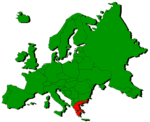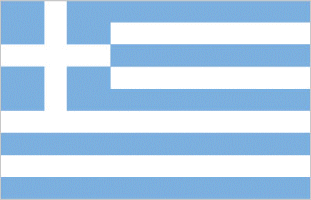| Hellenic Republic Ellinki Dhimokratia
Location southern
Europe
Bordered By Albania, Macedonia, Bulgaria, Turkey

Area 50,944 sq mi
(131,944 sq km)
Greatest Mainland Distance N-S 365 mi
(587 km)
Greatest Mainland Distance E-W 345 mi
(555 km)
Coastline 9,333 mi (15,020 km)
Highest Point Mount Olympus; 9,570 ft
(2,917 m)
Lowest Point Mediterranean coast; sea
level
Natural Resources lignite, petroleum,
iron ore, bauxite, lead, zinc, magnesite, marble, salt,
hydropower potential
Nationality
Greek
Population (July 2014 est) 10,775,557
Largest Cities Athens, Thessaloniki
Ethnic Groups Greek
Religions Greek Orthodox, Muslim
Languages Greek (official)
Capital Athens
Form of Government parliamentary
republic
Present Constitution Adopted June 11,
1975
Chief of State President Prokopis
Pavlopoulos (since March 13, 2015)
Head of Government Prime Minister Alexios
Tsipras (since January 26, 2015)
Cabinet appointed by the President on the
recommendation of the Prime Minister
Legislature unicameral Parliament (Vouli ton
Ellinon)
Judiciary Supreme Judicial Court; Special
Supreme Tribunal
Local Administration 13 regions (perifereis) and
1 autonomous monastic state (aftonomi monastiki
politeia)
Currency Euro
Per Capita Income $26,300
Industries tourism, food processing,
tobacco processing, textiles, chemicals, metal products,
mining, petroleum
Agricultural Products wheat, corn,
barley, sugar beets, olives, tomatoes, wine, tobacco,
potatoes; beef, dairy products
Export Commodities food and beverages,
manufactured goods, petroleum products, chemicals,
textiles
Import Commodities machinery, transport
equipment, fuels, chemicals
Independence Achieved
1829
From the Ottoman Empire
National Holiday Independence Day; March
25 (1821)
Flag nine equal horizontal stripes of
blue alternating with white; blue square in upper
hoist-side corner bearing a white cross, symbolizing
Greek Orthodoxy

SEE ALSO
Albania
Bulgaria
Turkey
Questions or comments about this
page?
|
 SKC Films Library
SKC Films Library
